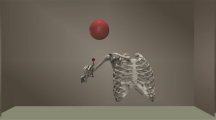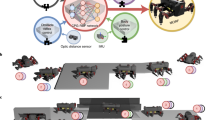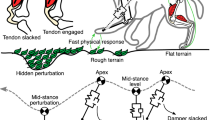Abstract
Robots will become ubiquitously useful only when they require just a few attempts to teach themselves to perform different tasks, even with complex bodies and in dynamic environments. Vertebrates use sparse trial and error to learn multiple tasks, despite their intricate tendon-driven anatomies, which are particularly hard to control because they are simultaneously nonlinear, under-determined and over-determined. We demonstrate—in simulation and hardware—how a model-free, open-loop approach allows few-shot autonomous learning to produce effective movements in a three-tendon two-joint limb. We use a short period of motor babbling (to create an initial inverse map) followed by building functional habits by reinforcing high-reward behaviour and refinements of the inverse map in a movement’s neighbourhood. This biologically plausible algorithm, which we call G2P (general to particular), can potentially enable quick, robust and versatile adaptation in robots as well as shed light on the foundations of the enviable functional versatility of organisms.
This is a preview of subscription content, access via your institution
Access options
Access Nature and 54 other Nature Portfolio journals
Get Nature+, our best-value online-access subscription
$29.99 / 30 days
cancel any time
Subscribe to this journal
Receive 12 digital issues and online access to articles
$119.00 per year
only $9.92 per issue
Buy this article
- Purchase on Springer Link
- Instant access to full article PDF
Prices may be subject to local taxes which are calculated during checkout






Similar content being viewed by others
Data availability
The source code can be accessed at https://github.com/marjanin/Marjaninejad-et.-al.−2019-NMI.
All other data (run data for experiments as well as the 3D printing files) can be accessed at https://drive.google.com/drive/folders/1FO0QJ2fBsdYCJs-h1LH7Iwb-wa0VPDi-?usp=sharing
References
Lowrey, K., Kolev, S., Dao, J., Rajeswaran, A. & Todorov, E. Reinforcement learning for non-prehensile manipulation: transfer from simulation to physical system. In Proc. 2018 IEEE International Conference on Simulation, Modeling, and Programming for Autonomous Robots (SIMPAR) 35–42 (IEEE, 2018).
Andrychowicz, M. et al. Learning dexterous in-hand manipulation. Preprint at https://arxiv.org/abs/1808.00177 (2018).
Kobayashi, H. & Ozawa, R. Adaptive neural network control of tendon-driven mechanisms with elastic tendons. Automatica 39, 1509–1519 (2003).
Nguyen-Tuong, D., Peters, J., Seeger, M. & Schölkopf, B. Learning inverse dynamics: a comparison. In Proc. European Symposium on Artificial Neural Networks 13–18 (2008).
Osa, T., Peters, J. & Neumann, G. Hierarchical reinforcement learning of multiple grasping strategies with human instructions. Adv. Robot. 32, 955–968 (2018).
Manoonpong, P., Geng, T., Kulvicius, T., Porr, B. & Wörgötter, F. Adaptive, fast walking in a biped robot under neuronal control and learning. PLoS Comput. Biol. 3, e134 (2007).
Marques, H. G., Bharadwaj, A. & Iida, F. From spontaneous motor activity to coordinated behaviour: a developmental model. PLoS Comput. Biol. 10, e1003653 (2014).
Gijsberts, A. & Metta, G. Real-time model learning using incremental sparse spectrum Gaussian process regression. Neural Netw. 41, 59–69 (2013).
Della Santina, C., Lakatos, D., Bicchi, A. & Albu-Schäffer, A. Using nonlinear normal modes for execution of efficient cyclic motions in soft robots. Preprint at https://arxiv.org/abs/1806.08389 (2018).
Bongard, J., Zykov, V. & Lipson, H. Resilient machines through continuous self-modeling. Science 314, 1118–1121 (2006).
Krishnan, S. et al. SWIRL: A sequential windowed inverse reinforcement learning algorithm for robot tasks with delayed rewards. Int. J. Rob. Res. https://doi.org/10.1177/0278364918784350 (2018).
James, S. et al. Sim-to-Real via Sim-to-Sim: Data-efficient Robotic Grasping via Randomized-to-Canonical AdaptationNetworks. Preprint at https://arxiv.org/abs/1812.07252 (2018).
Takahashi, K., Ogata, T., Nakanishi, J., Cheng, G. & Sugano, S. Dynamic motion learning for multi-DOF flexible-joint robots using active–passive motor babbling through deep learning. Adv. Robot. 31, 1002–1015 (2017).
Marco, A., Hennig, P., Bohg, J., Schaal, S. & Trimpe, S. Automatic LQR tuning based on Gaussian process global optimization. In 2016 IEEE International Conference on Robotics and Automation (ICRA) 270–277 (IEEE, 2016).
Geijtenbeek, T., Van De Panne, M. & Van Der Stappen, A. F. Flexible muscle-based locomotion for bipedal creatures. ACM Trans. Graph. 32, 206 (2013).
Kumar, V., Tassa, Y., Erez, T. & Todorov, E. Real-time behaviour synthesis for dynamic hand-manipulation. In Proc. 2014 IEEE International Conference on Robotics and Automation (ICRA) 6808–6815 (IEEE, 2014).
Kumar, V., Gupta, A., Todorov, E. & Levine, S. Learning dexterous manipulation policies from experience and imitation. Preprint at https://arxiv.org/abs/1611.05095 (2016).
Rombokas, E., Theodorou, E., Malhotra, M., Todorov, E. & Matsuoka, Y. Tendon-driven control of biomechanical and robotic systems: a path integral reinforcement learning approach. In Proc. 2012 IEEE International Conference on Robotics and Automation (ICRA) 208–214 (IEEE, 2012).
Potkonjak, V., Svetozarevic, B., Jovanovic, K. & Holland, O. The puller–follower control of compliant and noncompliant antagonistic tendon drives in robotic systems. Int. J. Adv. Robot. Syst. 8, 69 (2011).
Hunt, A., Szczecinski, N. & Quinn, R. Development and training of a neural controller for hind leg walking in a dog robot. Front. Neurorobot. 11, 18 (2017).
Fazeli, N. et al. See, feel, act: hierarchical learning for complex manipulation skills with multisensory fusion. Sci. Robot. 4, eaav3123 (2019).
Rasmussen, D., Voelker, A. & Eliasmith, C. A neural model of hierarchical reinforcement learning. PLoS One 12, e0180234 (2017).
Parisi, S., Ramstedt, S. & Peters, J. Goal-driven dimensionality reduction for reinforcement learning. In Proc. 2017 IEEE/RSJ International Conference on Intelligent Robots and Systems (IROS) 4634–4639 (IEEE, 2017).
D’Souza, A., Vijayakumar, S. & Schaal, S. Learning inverse kinematics. Intell. Robots Syst. 1, 298–303 (2001).
Bonarini, A., Lazaric, A. & Restelli, M. Incremental skill acquisition for self-motivated learning animats. In Proc. International Conference on Simulation of Adaptive Behavior 357–368 (Springer, 2006).
Najjar, T. & Hasegawa, O. Self-organizing incremental neural network (SOINN) as a mechanism for motor babbling and sensory-motor learning in developmental robotics. In Proc. International Conference on Artificial Neural Networks 321–330 (Springer, 2013).
Marjaninejad, A., Annigeri, R. & Valero-Cuevas, F. J. Model-free control of movement in a tendon-driven limb via a modified genetic algorithm. In 40th Annual International Conference of the IEEE Engineering in Medicine and Biology Society (EMBC) (IEEE, 2018).
Rajeswaran, A. et al. Learning complex dexterous manipulation with deep reinforcement learning and demonstrations. Preprint at https://arxiv.org/abs/1709.10087 (2017).
Schulman, J., Levine, S., Abbeel, P., Jordan, M. & Moritz, P. Trust region policy optimization. In International Conference on Machine Learning 1889–1897 (PMLR, 2015).
Mnih, V. et al. Human-level control through deep reinforcement learning. Nature 518, 529–533 (2015).
Salimans, T., Ho, J., Chen, X., Sidor, S. & Sutskever, I. Evolution strategies as a scalable alternative to reinforcement learning. Preprint at https://arxiv.org/abs/1703.03864 (2017).
Vinyals, O. et al. Starcraft II: a new challenge for reinforcement learning. Preprint at https://arxiv.org/abs/1708.04782 (2017).
Metta, G. et al. The iCub humanoid robot: an open-systems platform for research in cognitive development. Neural Netw. 23, 1125–1134 (2010).
Pathak, D., Agrawal, P., Efros, A. A. & Darrell, T. Curiosity-driven exploration by self-supervised prediction.Iin International Conference on Machine Learning (ICML) 2017, (2017).
Luo, Q. et al. Design of a biomimetic control system for tendon-driven prosthetic hand. In 2018 IEEE International Conference on Cyborg and Bionic Systems (CBS) 528–531 (2018).
Ravi, S. & Larochelle, H. Optimization as a model for few-shot learning. In Proc. ICLR (2016).
Schaal, S. in Humanoid Robotics: A Reference. (eds Goswami, A. & Vadakkepat, P.) 1–9 (Springer, Dordrecht, 2018).
Bohg, J. et al. Interactive perception: leveraging action in perception and perception in action. IEEE Trans. Robot. 33, 1273–1291 (2017).
Ingram, T. G. J., Solomon, J. P., Westwood, D. A. & Boe, S. G. Movement related sensory feedback is not necessary for learning to execute a motor skill. Behav. Brain Res. 359, 135–142 (2019).
Fine, M. S. & Thoroughman, K. A. Trial-by-trial transformation of error into sensorimotor adaptation changes with environmental dynamics. J. Neurophysiol. 98, 1392–1404 (2007).
Adolph, K. E. et al. How do you learn to walk? Thousands of steps and dozens of falls per day. Psychol. Sci. 23, 1387–1394 (2012).
Valero-Cuevas, F. J. Fundamentals of Neuromechanics 8 (Springer, New York, NY, 2015).
Marjaninejad, A. & Valero-Cuevas, F. J. in Biomechanics of Anthropomorphic Systems (eds Venture, G., Laumond, J.-P. & Watier, B.) 7–34 (Springer, New York, NY, 2019).
McAndrew, P. M., Wilken, J. M. & Dingwell, J. B. Dynamic stability of human walking in visually and mechanically destabilizing environments. J. Biomech. 44, 644–649 (2011).
Jalaleddini, K. et al. Neuromorphic meets neuromechanics. Part II: The role of fusimotor drive. J. Neural Eng. 14, 025002 (2017).
Loeb, G. E. Optimal isn’t good enough. Biol. Cybern. 106, 757–765 (2012).
Collins, S. H., Wiggin, M. B. & Sawicki, G. S. Reducing the energy cost of human walking using an unpowered exoskeleton. Nature 522, 212–215 (2015).
Kobayashi, T., Sekiyama, K., Hasegawa, Y., Aoyama, T. & Fukuda, T. Unified bipedal gait for autonomous transition between walking and running in pursuit of energy minimization. Rob. Auton. Syst. 103, 27–41 (2018).
Finley, J. M. & Bastian, A. J. Associations between foot placement asymmetries and metabolic cost of transport in hemiparetic gait. Neurorehabil. Neural Repair 31, 168–177 (2017).
Selinger, J. C., O’Connor, S. M., Wong, J. D. & Donelan, J. M. Humans can continuously optimize energetic cost during walking. Curr. Biol. 25, 2452–2456 (2015).
Zhang, W., Gordon, A. M., Fu, Q. & Santello, M. Manipulation after object rotation reveals independent sensorimotor memory representations of digit positions and forces. J. Neurophysiol. 103, 2953–2964 (2010).
Wolpert, D. M. & Flanagan, J. R. Computations underlying sensorimotor learning. Curr. Opin. Neurobiol. 37, 7–11 (2016).
Todorov, E. Optimality principles in sensorimotor control. Nat. Neurosci. 7, 907–915 (2004).
Grillner, S. Biological pattern generation: the cellular and computational logic of networks in motion. Neuron 52, 751–766 (2006).
Hebb, D. O. The Organization of Behavior: A Neuropsychological Theory (Wiley, New York, NY, 1949).
Ijspeert, A. J., Nakanishi, J. & Schaal, S. in Advances in Neural Information Processing Systems Vol. 15 (eds Becker, S., Thrun, S. & Obermayer, K.) 1547–1554 (MIT Press, Cambridge, MA, 2003).
Feirstein, D. S., Koryakovskiy, I., Kober, J. & Vallery, H. Reinforcement learning of potential fields to achieve limit-cycle walking. In Proc. 6th IFAC Workshop on Periodic Control System Vol. 49, 113–118 (Elsevier, 2016).
Acknowledgements
The authors thank H. Zhao for support in designing and manufacturing the physical system as well as support in the analysis of the limb kinematics, S. Kamalakkannan for support in designing and implementing the data acquisition system, and Y. Kahsai for Figs. 1 and 2. Research reported in this publication was supported by the National Institute of Arthritis and Musculoskeletal and Skin Diseases of the National Institutes of Health under award numbers R01 AR-050520 and R01 AR-052345 to F.J.V.-C. This work was also supported by Department of Defense CDMRP Grant MR150091 and Award W911NF1820264 from the DARPA-L2M programme to F.J.V.-C. The authors acknowledge additional support for A.M. for Provost and Research Enhancement Fellowships from the Graduate School of the University of Southern California and fellowships for D.U.-M. from the Consejo Nacional de Ciencia y Tecnología (Mexico) and for B.C. from the NSF Graduate Research Fellowship Program. The content of this endeavour is solely the responsibility of the authors and does not represent the official views of the National Institutes of Health, the Department of Defense, The National Science Foundation nor the Consejo Nacional de Ciencia y Tecnología.
Author information
Authors and Affiliations
Contributions
All authors contributed to the conception and design of the work and writing of the manuscript. A.M. led the development of the G2P algorithm, D.U.-M. led the construction of the robotic limb and B.A.C. led the data acquisition and analysis. F.J.V.-C. provided general direction for the project. All authors approved the final version of the manuscript and agree to be accountable for all aspects of the work. All persons designated as authors qualify for authorship, and all those who qualify for authorship are listed.
Corresponding author
Ethics declarations
Competing interests
The authors declare no competing interests.
Additional information
Publisher’s note: Springer Nature remains neutral with regard to jurisdictional claims in published maps and institutional affiliations.
Supplementary information
Supplementary Information
Supplementary Materials and Methods, Supplementary Discussion, Supplementary Figures 1–7, Captions for Supplementary Videos 1,2
Supplementary Video 1
Video for Figs 4, 5a and 6
Supplementary Video 2
Video for additional experiments
Rights and permissions
About this article
Cite this article
Marjaninejad, A., Urbina-Meléndez, D., Cohn, B.A. et al. Autonomous functional movements in a tendon-driven limb via limited experience. Nat Mach Intell 1, 144–154 (2019). https://doi.org/10.1038/s42256-019-0029-0
Received:
Accepted:
Published:
Issue Date:
DOI: https://doi.org/10.1038/s42256-019-0029-0
This article is cited by
-
Learning plastic matching of robot dynamics in closed-loop central pattern generators
Nature Machine Intelligence (2022)
-
Bio-robots step towards brain–body co-adaptation
Nature Machine Intelligence (2022)
-
Biological underpinnings for lifelong learning machines
Nature Machine Intelligence (2022)
-
A large calibrated database of hand movements and grasps kinematics
Scientific Data (2020)



